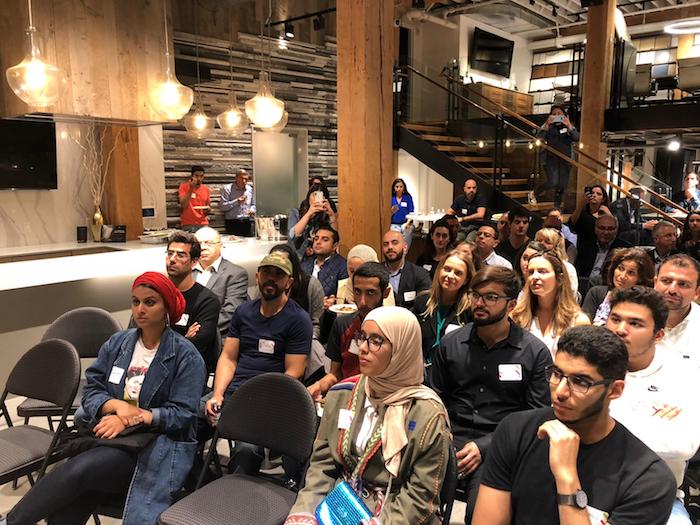Andre Haddad (left) talking to Rony Chammas about early beginnings and product/market fit. (Image via LebNet)
Andre Haddad left Beirut in 1989 because his parent’s house was bombed during the war. Fast forward 29 years, he is a successful entrepreneur and CEO of Turo, a peer-to-peer car sharing platform featuring 350,000 registered vehicles and 100 million signups.
How did it all begin?
On September 10, Haddad opened up about his success and lessons learned during a panel on peer economy, organized by LebNet and TechWadi. Around 100 people gathered in Cambria Gallery in San Francisco to listen to him talk about Turo achieving product/market fit, scaling, and dealing with challenges.
The session was moderated by Rony Chammas, the founder and chief product officer of Peerspace, a peer-to-peer marketplace for booking spaces for events, meetings, and film shootings in San Francisco.
From idea creation to product/market fit
Haddad laid the foundation of his success on a childhood passion. During the bombing of his hometown, his entire music collection was destroyed. When he moved with his family to France, he started buying music records and vinyl discs from eBay at bargain prices and have them shipped from the US, until one day he decided to launch a similar concept in his country of residence to spare himself the trouble of shipping. This is how he launched his first startup iBazar, which was acquired by eBay in 2001.
“That was my first step into the internet world and building something from scratch. During those times it was really challenging to know if it’s a good or bad idea,” said Haddad.
After taking on executive roles at Shopping.com and eBay, Haddad returned to the startup scene in 2011 and joined Turo (previously RelayRides) to solve another problem he faced.
Step one to achieve a product/market fit: solve your own problems, then solve the problems of others
His problem was he had many cars being the car enthusiast that he is, yet his cars weren’t being driven enough to stay in a good running condition. So he became passionate about Turo’s value proposition which allows users on the platform to rent and lease cars from other individuals
“I felt I was solving a problem, something I would be interested in solving as a consumer. It’s good to have a personal connection with the problem because you spend many years in your life to build it and pay for it and you go through lots of ups and down. If there’s no personal connectivity with the problem you’re solving it will be a lot harder to be successful in the product/market fit and be persuasive enough to have others join you,” he advised the audience.
That first step in the product/market fit did not require data tracking and analysis, but gut feeling, he said. Once entrepreneurs identify a real market need they should shift their focus towards metrics and data.
Step two to achieve a product/market fit: obsess about conversions
Conversion rates tracks how many of the people who downloaded the Turo application became real customers. A high organic conversion rate is a clear sign the product is a good fit.
Once entrepreneurs reach that phase, they should start thinking about scaling.
Step one to scale your company: spending money on user acquisition
Turo has around 10 million signups, 350,000 registered vehicles and 6 million booked days, according to Haddad. Yet, he believed his business is still in the early stages, “it’s not Airbnb and Uber,” this is why the team keeps looking at the number of downloads and bookings and spend more money to grow their traffic.
“When you have high conversion rates then you know there’s a strong probability people will download and use the app. So you start spending more money on acquiring new users and this further accelerates growth,” he explained.
Today, the team measures the money spent on ads closely to track how quickly will each paid customer generate revenues, in other terms ROI.
“Investors looking at Turo today are going to write a big check and know that most of the money we’re going to spend will be on marketing expenses. eBay even at its scale still spends 30 percent of its revenue on marketing,” he clarified.
The main takeaway? “You move away with just product/market fit and conversion towards creating a balance between free and paid traffic and how much are customers generating. Management of the business becomes more complex, metrics become less simple and cover a variety of things.”
Step two to scale your company: become more disciplined
To figure out product/market fit, you need to have a lot of passion and creativity, said Haddad. But to figure out scaling, you need a lot of discipline, data measurement and tracking and team management. Haddad stated that entrepreneurs need to start hiring people who are more intelligent than they are and need to figure out ways to keep them motivated.
“How do you bring people who don’t have the similar passion you have for the product you built, but empower them to run the business?” he asked rhetorically.
Like many entrepreneurs, the journey for Haddad was bumpy. “The car business is an 80 billion dollar market. There’s a lot of need for cars but what wasn’t clear back in 2011 was if anyone would be willing to share their car,” he said about the early beginnings. The first time he gave his Porsche keys to a stranger, he was petrified but he went with his instinct then scaled.
“Throw yourself into something you are really passionate about and be engaged with the problem you are solving. It’s hard to have the long-term commitment during the ups and downs if there’s no real connection, if it’s not part of your life,” Haddad concluded.

